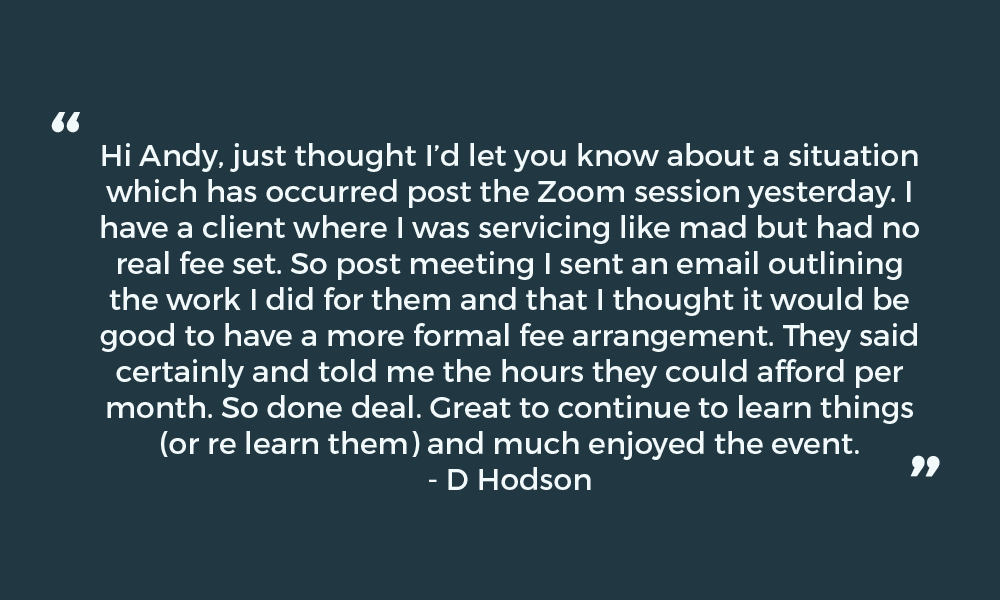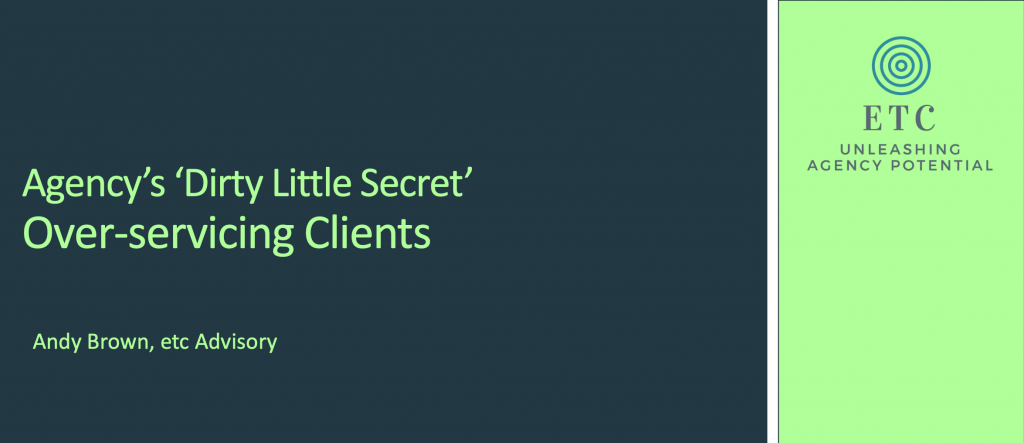Take solace (if you can) that over-servicing is something pretty much every agency does. A dirty little secret if you will. Except, it’s not really a secret, more something that has become so commonplace that it often barely registers as a problem. But a problem it is.
Recently, I was delighted to welcome a number of agency leaders and founders to an event on over-servicing clients. The event was so valuable because every person in attendance was open and candid about their own routine and all too over-familiar relationship with over-servicing.
If you missed it, you can listen to the full discussion below:
Post event, I received the following message from an attendee (which he kindly allowed me to share), so if you’re wondering if it’s worth a listen this might sway you.
So, hands up who’s ever over-serviced a client?
What do we mean by over-servicing?
- You’ve provided more hours than you agreed or planned
- You have an excess of unbillable time
- You have provided work/services/support at discounted prices or even for free
So even when you think you’re being ‘nice’…
The funny thing about overservicing clients? You think you’re doing right by the client, but eventually it catches up with you. You get frustrated because you feel taken advantage of (even though you created it). And the client is frustrated that you suddenly scaled back on the work you’re doing. Either way, you lose. The client loses. And yet…we continue to do it, daily, probably multiple times a day.
Why do we over-service clients?
Well, the reasons are both vast and varied, but I’ve jotted a few classic examples below. Recognise any of them?
- Over promising – often during the tender/pitch stage
- Under budgeting – miscalculating the time an d resources it will take to deliver a job, often during initial scoping
- Clients going feral – Poor client management – lack of training of your team or of the client, not setting boundaries, not anticipating this behaviour and therefore having to try to retro fit “rules” which no one wants to discuss and won’t follow anyway
- Over-Demanding clients
- Perceived importance of client – that client that everyone knows is critical to the agency’s health – in reality, they are often legacy clients who are far less profitable than you think.
- Perceived fragile client relationships – they’ll ‘break up with us’
- Lack of process – not tracking, measuring or reporting the right things
- Unwillingness to change – we’ve always done that little bit more
- Not valuing what you do
- Not recognising what you do (the value add)
- Bad/outdated SLA’s
- Weak scope of works
So how do you deal with over-servicing?
On time, on brief, on budget
First, you need to identify why the over-servicing is happening, and, if necessary, who the common culprits are for letting it happen.
- Recognise your value and the value you bring to the client – cost accordingly
- Track. Your. time
- Better SLA’s / Scope of work – define your deliverables and manage expectations
- Keep expectations in check
- Staff training – this is absolutely your team’s job, they must manage the client based on agreed SLA’s and push back where necessary – listen to the full recording for more insight into this.
- Anticipate extras and provide a cost and SLA for these up front – Make additional amends an extra cost, standard procedure
- Redefine your services so that you can attribute a value to them
- Reporting / Track results– report by client, by time, by team, by service
Once you’ve figured out the root causes, you can tackle each issue specifically. For instance, if it’s client services over promising, then it’s time for some serious staff training, especially around creating realistic scopes of work and SLAs. If it’s due to numerous additional amends (they quickly add up) then make sure everyone is trained and feels empowered to push back and make amends a clear, chargeable job.
Want a skim through the discussion slides? Take a look below…
Finally, in the session someone brought up the client mapping diagram, below.
The premise behind this diagram is that ideal client has strong revenues and potential for cross-sell and up-sell to deepen the relationship.Not all clients can be here, but it is important to regularly assess your client portfolio to understand where they sit on the Growth Potential/Revenue axes.
A low growth potential, low revenue client needs to change or it will be a drain on your business. You need a plan to develop high growth potential clients with lower revenue, and those with higher rev but no opportunity to grow should be nurtured.
I’d love to hear your experiences of over-servicing. Have you managed to find a way to minimise it? Please do share you thoughts.
If you’d like to receive more articles about common agency problems then make sure you’ve signed up to my weekly email, Rambling On.
Andy.


